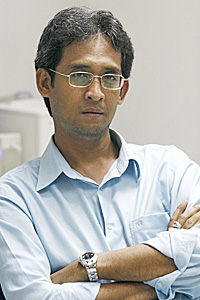
The controversy over the winning design of Suvarnabhumi airport's second passenger terminal does not only relate to allegations of plagiarism but also the lack of a unique identity.
The controversial decision by the Airports of Thailand (AoT) to grant a 329-million-baht design work contract to the second runner-up has raised the question: What is the ultimate goal of the design contest?
The airport authority has planned to construct the second terminal to accommodate the sharply rising number of visitors at the airport, with an estimated construction cost of 35 billion baht. The new terminal is due to be fully operational by 2021 or 2022.

Soonruth Bunyamanee is acting editor, Bangkok Post.
In March, it invited private firms to compete for the terminal's design.
Originally, SA Group, comprising SPAN Consultants and Sign-Tech Engineering Consultant, was named the winner. But the AoT disqualified the group due tor a documentation error, even though it won the highest score in terms of technical criteria (design work).
The AoT claimed SA Group failed to submit the original quotation for the design cost even though a related document was provided to them. As a result, the airport authority invited the second runner-up, DBALP Consortium, headed by renowned Thai architect Duangrit Bunnag, to negotiate and finally gave the work to the group.
The design work of the DBALP, however, was criticised for being similar to that of the Yasuhara Wooden Bridge Museum by Japanese architect Kengo Kuma.
Mr Duangrit denied plagiarising the work, saying those who follow his work would know he has created similar images in his previous designs, including for a hotel in Sri Lanka.
The Architect Council of Thailand has questioned the AoT's decision to rush the submission of designs and quotations in order to conclude the process just two days before a new law on state procurement took effect. The new law prescribes stricter regulations on bidding for government projects.
It said the AoT must be cognisant of the new regulations because the law was published in the Royal Gazette 180 days prior to taking effect.
SA Group has filed a complaint with the government alleging AoT is guilty of unfair treatment. It reportedly plans to file a petition with the Central Administrative Court.
Both claims need to be proven by the relevant agencies and experts. However, the AoT needs to immediately revise its decision to reward the second runner-up with the design contract.

Suvarnabhumi airport's second passenger terminal is shown under construction in this July 26, 2018 file photo. Airports of Thailand has awarded a 329-million-baht contract to design the terminal to the second runner-up in a bidding contest but the artist has since been accused of plagiarism. (Photo by Chanat Katanyu)
No matter whether the DBALP's design work represents a case of plagiarism or not, it is still not the best one in the competition because the real winner was technically disqualified.
How can the AoT allow an inferior design work to be used for such a showpiece as the international airport's new terminal?
Aimed to accommodate an additional 30 million visitors a year, the new terminal should be built based on the design considered the best, not the one that needs to prove it is not a work of plagiarism.
Even though Mr Duangrit of DBALP insisted the design is his own work, it is still similar to a hotel he designed in Sri Lanka.
This means it could still be considered a partial plagiarism, or at least cannibalisation, of his own work.
So will his design give the new terminal a unique or shared identity?
More than 300 million baht of the state's budget is supposed to be spent on the best design, showcasing the authentic identity of the new terminal.
It should categorically not remind visitors of a hotel in another part of Asia.
According to the Architect Council of Thailand, the AoT's design contest should involve at least two steps.
The first would be the submission of proposed ideas, allowing bidders to present the concept of their design. Those who pass this step would be allowed to enter the second process -- the design contest.
The first step would allow the AoT to scrutinise bidders' proposals, asking them about the inspiration for their design ideas and what identity they represent.
At the same time, this process can allow itself some time to cross-check whether any of the designs presented are similar to existing ones.
But the design contest for the AoT's second terminal bypassed that crucial first step.
The AoT may have full authority to disqualify the winner, SA Group, citing its failure to submit a quotation.
Such a rationale is fine. But the AoT must also justify whether the second runner-up's design deserves the contract.
Surely, the AoT wants the best design for the new terminal. That is why the bid was organised.
If the winner is disqualified and the second runner-up remains subject to further scrutiny amid suspicion of plagiarism, the airport authority should call for a new bid, instead of passing the contract to the DBALP.
The government should take serious action on this case. It should not allow a questionable design to represent the new terminal of this prestigious international airport.
